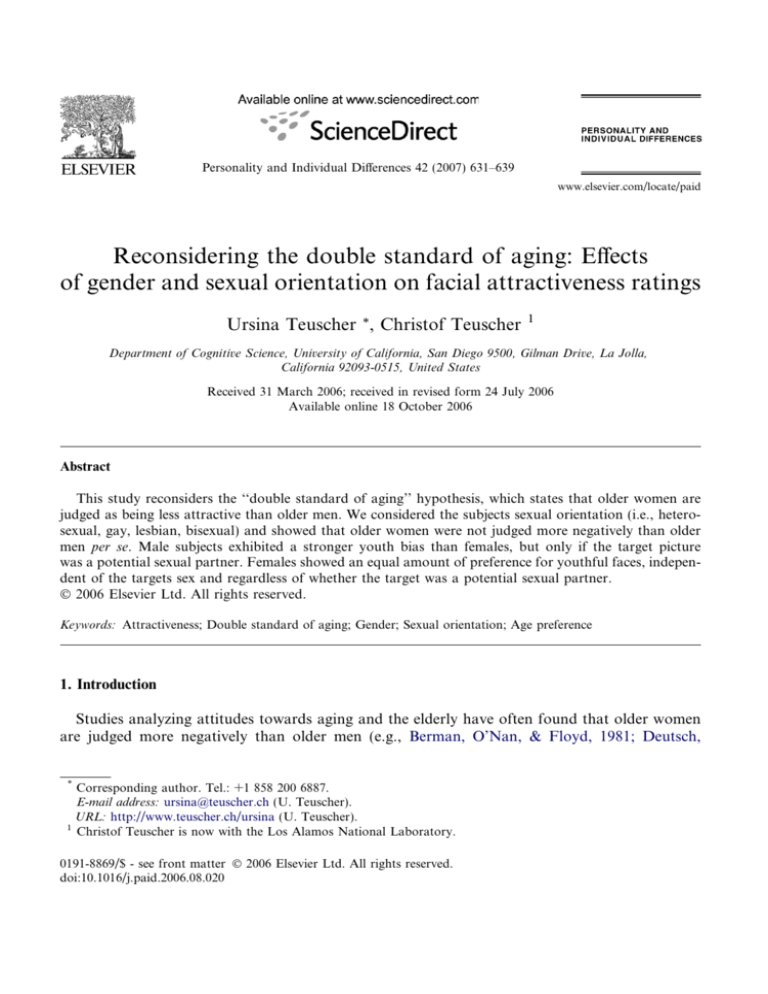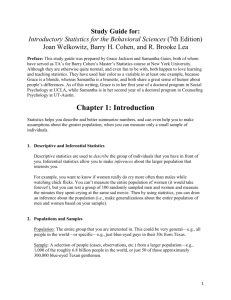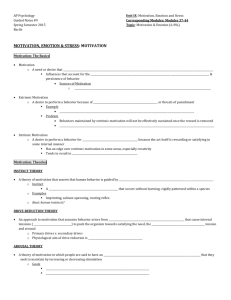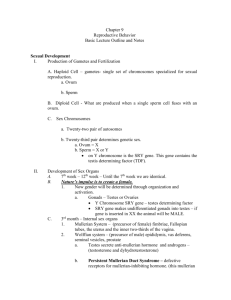
Personality and Individual Differences 42 (2007) 631–639
www.elsevier.com/locate/paid
Reconsidering the double standard of aging: Effects
of gender and sexual orientation on facial attractiveness ratings
Ursina Teuscher *, Christof Teuscher
1
Department of Cognitive Science, University of California, San Diego 9500, Gilman Drive, La Jolla,
California 92093-0515, United States
Received 31 March 2006; received in revised form 24 July 2006
Available online 18 October 2006
Abstract
This study reconsiders the ‘‘double standard of aging’’ hypothesis, which states that older women are
judged as being less attractive than older men. We considered the subjects sexual orientation (i.e., heterosexual, gay, lesbian, bisexual) and showed that older women were not judged more negatively than older
men per se. Male subjects exhibited a stronger youth bias than females, but only if the target picture
was a potential sexual partner. Females showed an equal amount of preference for youthful faces, independent of the targets sex and regardless of whether the target was a potential sexual partner.
Ó 2006 Elsevier Ltd. All rights reserved.
Keywords: Attractiveness; Double standard of aging; Gender; Sexual orientation; Age preference
1. Introduction
Studies analyzing attitudes towards aging and the elderly have often found that older women
are judged more negatively than older men (e.g., Berman, O’Nan, & Floyd, 1981; Deutsch,
*
Corresponding author. Tel.: +1 858 200 6887.
E-mail address: ursina@teuscher.ch (U. Teuscher).
URL: http://www.teuscher.ch/ursina (U. Teuscher).
1
Christof Teuscher is now with the Los Alamos National Laboratory.
0191-8869/$ - see front matter Ó 2006 Elsevier Ltd. All rights reserved.
doi:10.1016/j.paid.2006.08.020
632
U. Teuscher, C. Teuscher / Personality and Individual Differences 42 (2007) 631–639
Zalenski, & Clark, 1986; Laurence, 1964). This phenomenon was first referred to as the ‘‘double
standard of aging’’ by Susan Sontag (1972), who suggested that modern urbanized societies allow
two standards of male beauty: the boy and the man, but only one standard of female beauty: the
girl. An explanation for this is provided by evolutionary theories: they assert that youthfulness is a
more salient cue for men than for women when faced with the task of mate selection, due to the
fact that women’s fertile years are typically more limited than men’s, and more precipitously terminated by the onset of menopause (cf. Bailey, Gaulin, Agyei, & Gladue, 1994; Kenrick & Keefe,
1992).
Previous studies have suggested that men are attracted to relatively younger women (Kenrick &
Keefe, 1992), that men place greater emphasis on physical attractiveness because of its value as an
age cue (Buss, 1989; Feingold, 1990; Thornhill & Gangestad, 1999) and health indicator, that women’s femininity is perceived to decrease with age, which is not the case for men’s masculinity
(Deutsch et al., 1986), and that age is a more salient cue for men than for women (Kogan,
1974, 1979). Thus, most studies have been supportive of the double standard of aging hypothesis,
although there have been exceptions for attractiveness ratings (Zebrowitz, Olson, & Hoffman,
1993), for attitudes towards the elderly (Kite, Deaux, & Miele, 1991; Öberg & Tornstam,
2003), and for the double standard in self-perceptions (Wilcox, 1997). In general, a more substantial and consistent effect of a double standard of aging was found when photographic stimuli were
used as opposed to verbal descriptions (for an overview of the earlier studies see Kogan & Mills,
1992).
In most of these previous studies involving picture ratings, the sexual orientation of the subjects
was not recorded and we can thus assume that the subjects were mostly heterosexual. As a consequence, there has mostly been a confound between the sex of the subject and the sex of the target as a potential mate. For male subjects, the targets displaying potential mates were female, and
for female subjects, the targets displaying potential mates were male. This confound makes it
impossible to tell if the reason for the documented sex of subject by sex of target interaction lies
in the target or in the subject. An evolutionary explanation, as proposed for example by Kenrick
and Keefe (1992), would suggest that it is due to the subject as it is more important for men than
for women that their sexual partner is youthful. But it is also conceivable that sex of subject by sex
of target interactions result because women’s appearance is indeed more susceptible to the effects
of aging, due for instance to greater physiological or hormonal changes, or that beauty standards
are different for men and women through socio-cultural norms.
A study by Silverthorne and Quinsey (2000) included homosexual men and women in their
samples and found indeed that the variance could be explained by the subject better than by
the target. That is, homosexual and heterosexual men would prefer younger partners of their preferred sex than would homosexual and heterosexual women. However, since Silverthorne and
Quinsey asked their participants specifically for ratings of the targets’ sexual attractiveness, only
the ratings for the preferred sex (opposite sex for heterosexual participants, same sex for homosexual participants) can be interpreted, since the ratings for the targets belonging to the other sex
were all very close to the minimum, across all age groups.
The goal of the present study was to elucidate the effect of age on attractiveness ratings for both
the preferred and the unpreferred sex. Specifically, we were interested in whether men showed a
stronger preference for youthful faces than women in general, even when the face was not a potential mate, or whether the stronger preference for youthfulness was limited to potential mates.







